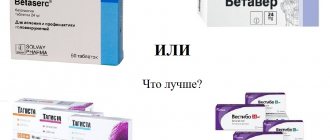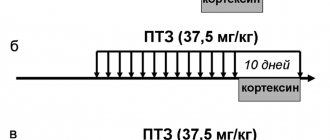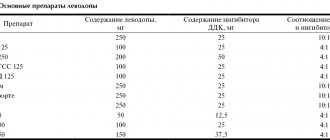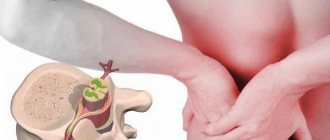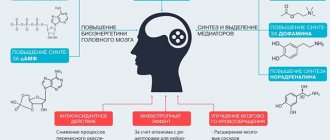Effect of the drug
Paracetamol has been considered a popular and sought after pain reliever and antipyretic for half a century. Efficiency is associated with uniform distribution across tissues.
The active ingredients block the action of prostaglandins, which are sources of pain. This eliminates moderate pain. The drug also copes well with fever. This serious symptom can indicate a variety of infectious and inflammatory diseases.
Before taking it, you should consult your doctor and read the instructions to prevent side effects. You should strictly follow the dosage, otherwise complications related to the functioning of the heart and kidneys may occur. The risk increases when taken concomitantly with alcoholic beverages.
Signs of poisoning do not appear immediately. Initially, your general well-being may only slightly deteriorate.
Benefits of using paracetamol for colds or flu
The first antipyretic drug was discovered more than 100 years ago - it was acetylsalicylic acid, known to everyone as aspirin3. Later, other non-steroidal anti-inflammatory drugs with an antipyretic (antipyretic) effect appeared, in particular derivatives of pyrozolone (analgin) and propionic acid (ibuprofen), as well as aniline-based drugs (paracetamol)3. All of them entered the arsenal of means to combat fever, but over time, convincing data began to appear and accumulate about the high risk of side effects, in particular in children3, which can develop when taking certain medications.
Why did paracetamol tablets take a place on the list of essential drugs2?
Antipyretics should be as effective and safe as possible. It is these indicators that serve as a guideline when choosing a medicine to combat fever.
Acetylsalicylic acid (aspirin), which is relatively safe for adults, is not recommended for use in the treatment of children and adolescents3,6. It can cause Reye's syndrome, a rare but dangerous disease that develops when taking salicylates for certain viral and bacterial infections3,6. In addition, aspirin, like any non-steroidal anti-inflammatory drug, can provoke bronchospastic syndrome (aspirin-induced bronchial asthma), which is accompanied by narrowing of the bronchi and manifests itself as difficulty breathing. Such side effects have not been recorded for drugs containing paracetamol7.
Metamizole preparations (analgin) can disrupt hematopoiesis and cause agranulocytosis - a sharp decrease in the number of granular leukocytes3,4, which are known to provide nonspecific protection against pathogens of infectious diseases. Analgin, unlike paracetamol, can only be used with the permission of a doctor once in emergency situations when other drugs do not reduce the temperature3.
As for ibuprofen, it is also approved for over-the-counter sale and use for fever in adults and children6. Ibuprofen reduces temperature well3,5, but is dangerous from the point of view of the development of complications from the gastrointestinal tract. Like any non-steroidal anti-inflammatory drug, it can negatively affect the mucous membrane of the stomach and duodenum8.
Why do doctors recommend paracetamol? It is devoid of some of the side effects inherent in the listed antipyretic drugs.
- Paracetamol is not a non-steroidal anti-inflammatory drug, so the risk of complications from the stomach and duodenum is minimal1.
- It does not provoke the development of bronchospasm and “aspirin-induced” bronchial asthma1 in patients predisposed to them.
- It does not cause Reye's syndrome and is approved for use in children4.
Up to contents
In what cases is it effective?
The drug has an effect in various febrile conditions associated with elevated temperature. Particularly effective for colds.
Paracetamol is able to cope with pain of varying intensity. It is often used for headaches and toothaches. Helps women with pain during menstruation.
The drug is allowed to be taken by pregnant women and babies from 3 months. For children there are baby candles and syrup. The product is often given to babies who are starting to cut their teeth.
Paracetamol for fever
Paracetamol can be used at a temperature if it has reached 38.5 degrees or higher. This is explained by the fact that elevated temperature has a negative effect on harmful microorganisms, and, therefore, allows you to recover faster.
It should be taken strictly according to the instructions, without exceeding the dosage. The tablet should be taken with a sufficient amount of drinking water, which will speed up the absorption of the active ingredient and minimize the negative impact on the liver.
Single dose 400-500 mg. If the temperature reaches 40 degrees, the dose can be doubled.
For children and adults, a single dose is determined based on weight. A child can take the drug 4 times per day. Duration of treatment – up to 3 days.
Recommended dosage and regimen
The pharmacological effects of paracetamol are dose dependent3. Adults and adolescents over 12 years of age are recommended to take 500 mg of the drug up to 4 times a day7. In this case, the daily dose of the drug should not exceed 4 g (4000 mg)7.
Paracetamol begins to act within 30-60 minutes, maintaining its effect for up to 3-6 hours3. If the temperature does not decrease well enough or continues to rise, you need to call a doctor at home.
For children, the optimal dose of paracetamol is calculated based on 10-15 mg per 1 kilogram of body weight5. According to some sources, it is not advisable to use paracetamol at a dose of 10 mg/kg3. Insufficient effect can lead to frequent use of the drug and its overdose. Exceeding recommended doses is also unacceptable: the daily dose of paracetamol for children should not exceed 60 mg/kg body weight3.5.
Paracetamol, like any antipyretic drug, should not be taken as a course and “for the prevention” of fever5. It should be used to reduce elevated body temperature as needed - optimally 3 days3.5.
The temperature should not be reduced to “normal” numbers. It is enough to reduce it by 1-1.50 C6, and not sharply, but in 30-60 minutes4; this is usually easily achieved with the help of paracetamol drugs3.
Important! When using paracetamol, it is important to remember that:
- Antipyretics do not act on infectious agents, do not shorten the duration of the disease or the overall duration of fever, and in some cases slow down the elimination of viruses from the body3.
- Forced reduction in temperature may mask the development of bacterial complications that require the use of antibiotics3.
- Normalizing temperature with the help of antipyretics can create the illusion of well-being when treatment is insufficiently effective3.
Up to contents
How to take for headaches
The medicine is quite effective for headaches. But when taking it, it is worth considering some features. The tablets should not be taken on an empty stomach. Before taking the pill, you need to have at least something to eat. If there is no appetite, then you can drink a glass of water.
You need to take the tablet with plain water. It is not recommended to use coffee and tea, as the effect may be reduced to zero. If unbearable pain is felt, then you can take 1000 mg of the drug at a time. You can take the medicine again after at least 4 hours. You can take no more than 4 tablets per day. This regimen does not apply to pregnant women (the dosage should be 2 times less).
Paracetamol is prescribed for migraines, which are characterized by persistent, throbbing pain, usually in one part of the head.
If the headache is associated with stress or a nervous condition, then 1 tablet is enough.
Combination preparations based on paracetamol
Combination drugs occupy a special place in the treatment of ARVI1. Thanks to the presence of components that complement the action of paracetamol, such powders and tablets help relieve all the main symptoms of a cold in adults and children1: fever, nasal congestion, rhinorrhea, discomfort in the throat and weakness.
RINZA® brand preparations contain paracetamol and other active ingredients that are intended for the symptomatic treatment of colds, that is, to combat fever and chills, to relieve headaches, sore throat, muscles and joints, to reduce nasal congestion and rhinorrhea9,10,11 .
RINZA® in tablets for oral administration is approved for use from 15 years of age9. In addition to paracetamol, the drug contains caffeine, phenylephrine hydrochloride and chlorphenamine maleate9.
- Caffeine dilates the superficial blood vessels of the skin and thereby increases heat transfer, stimulates the nervous system, and helps fight drowsiness and lethargy9. In addition, it accelerates the absorption of paracetamol and enhances its analgesic effect12.
- Phenylephrine has a vasoconstrictor effect: it constricts the vessels of the mucous membrane of the respiratory tract and nasal cavity, helping to reduce its swelling and facilitate breathing9.
- The antiallergic effect of chlorphenamine is aimed at reducing sore throat, itchy eyes and nasal congestion9.
Each RINZA® tablet contains 500 mg of paracetamol. Adults, according to the instructions for use, should take no more than 4 tablets per day.
RINZASIP® with vitamin C - powder for preparing a hot drink. Among other ingredients, it contains 750 mg of paracetamol and ascorbic acid (vitamin C), which can help strengthen the immune system and increase resistance to infection. The optimal dose of the drug for adults and children over 15 years of age is 1 sachet per glass of hot water 3-4 times a day.
RINZASIP® for children over 6 years of age, in addition to paracetamol, contains pheniramine maleate, which acts similarly to phenylephrine, and vitamin C. The drug is also available in the form of a powder for preparing a solution and has a pleasant raspberry taste11, which is usually liked by children.
Depending on the age of the child, the drug is used in the following doses with an interval of at least 4 hours:
- children from 6 to 10 years old: 1 sachet 2 times a day;
- children from 10 to 12 years old: 1 sachet 3 times a day;
- children from 12 to 15 years old: 1 sachet 4 times a day.
Important to remember! The appearance of cold symptoms is a reason to consult a doctor. Paracetamol and its drugs do not treat acute respiratory viral infections and influenza, therefore, if the condition worsens sharply, the temperature does not go down and continues to rise, and the fever persists for more than 3 days, you need to call a local general practitioner at home.
If a child gets sick, there is no need to self-medicate; you should immediately seek medical help from a pediatrician.
The information in this article is for reference only and does not replace professional advice from a doctor. To make a diagnosis and prescribe treatment, consult a qualified specialist.
Up to contents
Paracetamol for colds
When a cold appears, you need to provide timely help. Otherwise, the condition may worsen. The first signs of the disease are excessive weakness and fatigue. During ARVI, a runny nose, cough, fever, muscle and joint pain appear.
Paracetamol will reduce the symptoms of the disease and improve the patient's condition.
Very often the drug is prescribed to adults and children over 12 years of age in tablet form. If the medicine is to be taken by children, then it is worth considering an important factor - the child must weigh more than 49 kg.
Babies up to one year old can be given the drug in the form of a suspension, after a year - in the form of syrup.
In many cases, adults take 1 tablet 4 times a day. Duration of treatment – no more than 3 days.
Effect of paracetamol for colds
Fever is the first thing that paracetamol helps with. To understand how it works, let’s figure out why the temperature rises in general.
Fever in acute respiratory diseases is a protective-adaptive reaction that develops in response to the penetration of infectious agents into the body4. Viruses and inflammatory products act as pyrogens3. They enter the blood and along with it are carried into the brain, where the thermoregulation center is located, which is responsible for maintaining normal body temperature3.
Pyrogens act on the thermoregulation center, thereby increasing heat production and reducing heat transfer in the body3. The result of these processes is an increase in body temperature.
Paracetamol blocks the enzyme cyclooxygenase (COX), which triggers the synthesis of prostaglandins, reduces the effect of pyrogens on the thermoregulation center and thereby helps fight fever7.
After oral administration, the maximum concentration of paracetamol in the blood is reached within 30-60 minutes3, at the same time the body temperature decreases. The duration of action depends on the dose5. Thus, research has established that the optimal effect in children is achieved by administering paracetamol at a rate of 15 mg per kilogram of body weight5. Adults are recommended to take 500 mg of paracetamol up to 4 times a day7.
The effect of paracetamol on the central nervous system also provides its analgesic effect, which develops in parallel with the antipyretic effect.
Up to contents
How to take for toothache
Often toothache catches a person at the most inopportune moment. Not in all cases it is possible to go to the dentist right away. To eliminate unbearable pain and improve the condition, you can take Paracetamol.
The drug is able to stop the production of prostaglandins, which are the source of pain. The tooth stops hurting, but the inflammatory process continues to spread. If the toothache does not go away, then you should not hesitate to go to the dentist.
You need to take the medicine after meals. Relief is observed after about 15-20 minutes. You can take the pill again no earlier than after 4 hours. You can take 4 tablets per day. Paracetamol can be taken for no more than 3 days.
Features of use by pregnant women
Pregnant women often complain of toothache. Most often, the cause is caries, which appears due to the fact that calcium in a woman’s body is directed to a greater extent towards the structure of the bone tissue of the unborn baby. This causes various problems, particularly with teeth.
Paracetamol is allowed to be taken by pregnant women, but precautions should be taken. The active substance can penetrate the placenta. The minimum dose of the medicine can be taken in the 2nd trimester, when the child’s organs are already formed.
Before taking it, you should consult your doctor. You can drink no more than 1 tablet per day. Repeated use may cause harm to the fetus.
